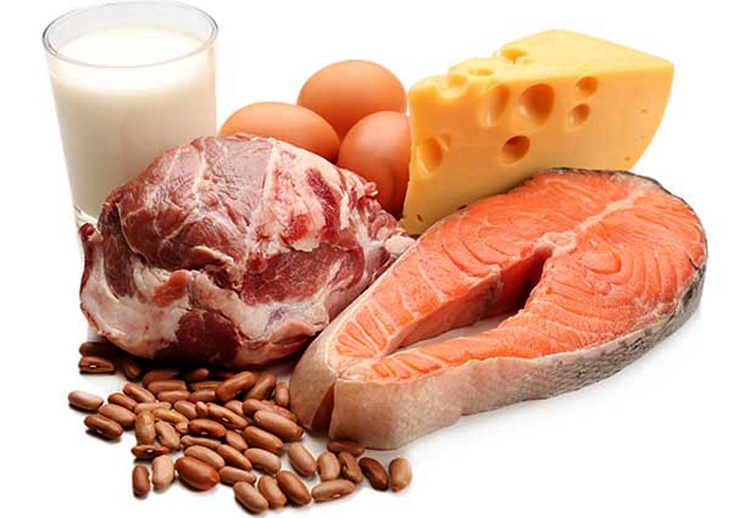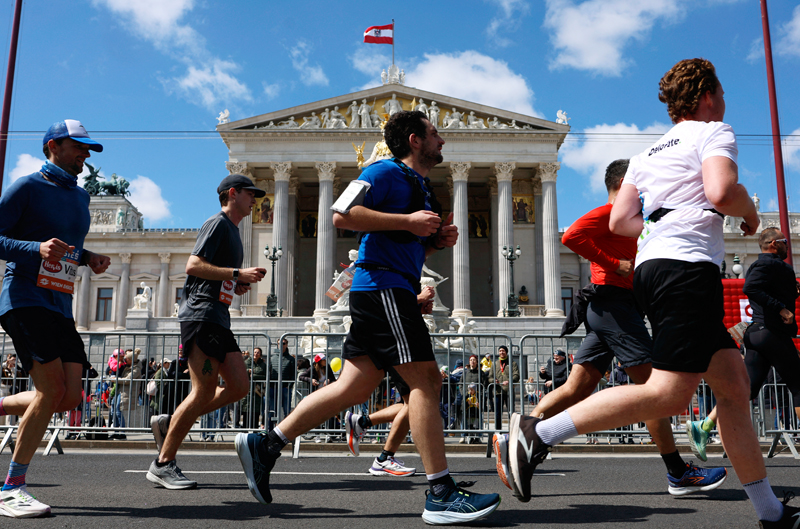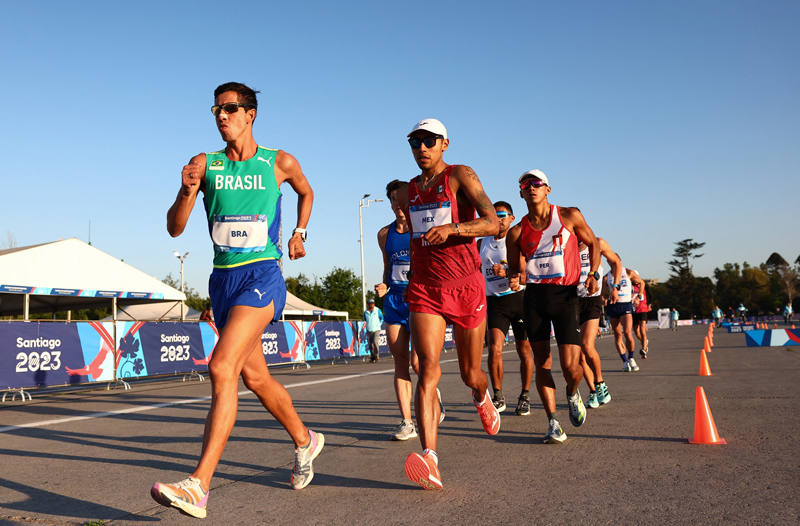You are viewing 1 of your 1 free articles. For unlimited access take a risk-free trial
Fat adaptation: a fat lot of good?

Many athletes are familiar with the concept of training ‘periodisation’, where training volume and intensity are deliberately structured in distinct phases in order to peak for a specific event, while allowing adequate recovery. In recent years however, ‘dietary periodisation’ has been proposed for endurance athletes as a way of enhancing fat metabolism and conserving precious muscle glycogen. But does it work? Andrew Hamilton looks at the evidence.
Although it sounds exotic, if you participate in an endurance sport such as running or cycling, dietary periodisation is something that you’ve probably already practiced without realising. Think about your last long-distance event. Did you manipulate your dietary patterns away from normal in the days leading up to that event, for example by increasing your carbohydrate? If you did, you were practising a simple form of dietary periodisation!
The consensus among sports nutritionists is that athletes need to ensure optimum dietary practices each and every day in order to fully support training and recovery. This leads to a ‘steady state’, where the composition of the diet stays fairly constant and (hopefully) optimised for that athlete. Dietary periodisation on the other hand involves departing from the normal ‘best practice’ in order to bring about a specific metabolic adaptation that might improve performance in a future event.
There are a number of examples of the use of dietary periodisation in sport; marathon runners who carbohydrate load before the big day; boxers and wrestlers who diet down before a contest to make their fighting weight; bodybuilders who follow ultra low-fat and low-sodium diets in order to become ‘ripped’ before a contest. And in more recent years, a new type of dietary periodisation practice has emerged - the manipulation of diet in the run up to an endurance event to enhance fat oxidation as a source of energy during the event. This periodisation strategy involves altering fat metabolism and for this reason is sometimes known as ‘fat adaptation’.
WHY PERIODISE USING FAT ADAPTATION?
Although fat and protein can both serve as fuel sources, regular PP readers will be well aware of the critical importance of carbohydrate as a premium grade fuel for vigorous exercise. There are several reasons why carbohydrate is such an important fuel, but one of the most important is that only carbohydrate can supply energy rapidly enough to generate ATP (the energy releasing molecule used to drive muscular contraction) during vigorous exercise. Although fat is a rich source of energy, the energy it contains cannot be released without the presence of oxygen, so it cannot play any part in fuelling anaerobic (ie very vigorous) exercise.
Another reason for the critical importance of carbohydrate is that even when exercise intensity is lower, and more of the energy can be derived from fat, a continual breakdown of carbohydrate is required to allow the efficient oxidation of fat for energy. This is because the fragments of fat molecules formed in the first stage of fat oxidation (acetyl-CoA) can only undergo the second stage of oxidation when combined with a molecule called oxaloacetic acid, the main source of which is from carbohydrate metabolism. If there’s not enough carbohydrate being broken down, fat metabolism is also compromised. This explains the saying that ‘fat burns in a carbohydrate flame’. Molecular fragments of fat (acetyl-CoA) from the early stages of oxidation need to combine with oxaloacetic acid from (mainly) carbohydrate metabolism in order to enter the ‘aerobic furnace’ of the Citric Acid Cycle’ and release their energy in the form of ATP
STORAGE
Carbohydrate then is the fuel of choice for vigorous exercise, but there’s a major problem and that’s storage. Even well-trained endurance athletes can only store about 400g of muscle carbohydrate (glycogen) and around 100g of liver glycogen. And since carbohydrate supplies 4kcals of energy per gram, this amounts to not much more than 2000kcals in total – enough to fuel a little over two hours of extremely vigorous exercise.
Compare this with fat; a 70 kilo athlete with a low body fat level of 10% carries 7 kilos of fat. But since fat supplies 9kcals per gram, this equates to 63,000kcals of available energy! More typically, the average adult stores over 100,000kcals of fat energy and this explains why fat is the preferred source of energy for the body when rapid energy supply is not the priority.
FOCUSING ON FAT
The most popular and successful nutritional strategies for prolonging high-intensity endurance exercise have been carbohydrate focussed - ie maximising glycogen before an event (carbohydrate loading), replenishing carbohydrate during an event (carbohydrate feeding) and replenishing lost carbohydrate immediately after training or competition (1). However, if carbohydrate was the only source of energy during vigorous exercise, these strategies would still be insufficient to ensure sufficient levels of muscle carbohydrate throughout a long event such as the marathon, and even elite runners would hit a brick wall before crossing the finishing line!
Fortunately, well-trained endurance athletes can supply a significant proportion of their energy needs from fat, even at high levels of VO2max, which means that the rate of depletion of muscle glycogen during an event such as the marathon is slowed, thereby maintaining sufficient stores to complete a marathon without hitting the ‘wall’.
DIETARY PERIODISATION AND FAT ADAPTATION
The principle of enhancing fat oxidation rates in order to conserve glycogen, thereby prolonging high-intensity endurance capability is precisely the goal of dietary periodisation to produce fat adaptation. The theory goes like this: before an important event, consume a high fat diet for 3-7 days followed by a high carbohydrate diet. During the high-fat period, the body ‘adjusts’ by increasing the proportion of energy derived from fat – an effect that is sustained for a few days even when the diet switches over to high-carbohydrate. The high-carbohydrate period then helps to ensure that muscle glycogen stores are fully replenished. The net result is muscles topped up with glycogen and an increased fat oxidation rate, which combine to conserve glycogen stores and prolong maximum output during an endurance event. But what’s the evidence that this type of dietary periodisation actually works?
There’s certainly no doubt that high-fat diets up-regulate enzymes in the body, resulting in higher rates of fat oxidation. In a study carried out in 2002, scientists studied the effect of 5 days of high-fat intake followed by 1 day of high carbohydrate intake, or 6 days of high carbohydrate intake on eight endurance-trained athletes (all diets contained the same number of calories) (2). During the 5-day trial period, the subjects continued to train as normal, but on the 6th day (high carbohydrate diet for all subjects), they rested. Both groups then cycled for 2 hours at 70% VO2max on day 7, and then performed a time trial lasting approximately 25 minutes. By taking respiratory exchange ratio measurements in both groups of subjects, the researchers found that:
• Fat oxidation before and during the 2-hour steady state ride was increased in the high-fat diet group, despite the fact that the subjects had consumed a high-carbohydrate diet the previous day;
• Carbohydrate oxidation in this group was also reduced;
• Time trial results were not significantly different between the two groups (more later).
In the second study the same year, 7 endurance athletes underwent a shorter ‘fat adaptation’ period of just 3 days (3). After a consuming a standardised diet on day 1, the subjects consumed either a high-carbohydrate or an isocaloric (ie containing the same number of calories) high-fat diet for 3 days. On day 5, all the subjects completed a lab training session consisting of a 20-minute warm up at 65% VO2max, followed by 8 x 5-minute bouts at 86% of VO2max with one minute recovery in between. After an 18-day period, the groups were switched – ie those who had followed the high-fat regime followed high carbohydrate and vice-versa – and the trial was repeated.
Results showed that after the high-fat diet, the rate of fat oxidation increased from 31 to 61micromol/kg/min – almost 100% increase. However, although the work rate was maintained on the high-fat diet, the perceived rate of exertion increased from an average of 13.8 to 16.0.
HOW DOES FAT ADAPTATION OCCUR?
Other studies have also confirmed that dietary periodisation consisting of a high-fat diet for a few days does indeed enhance the rate of fat oxidation and even spares carbohydrate reserves (4,5) So how does fat adaptation occur?
A study on 7 male cyclists looked at metabolic changes that occurred after five days of a high-fat diet while training, followed by one day of high-carbohydrate intake and compared these to 6 days of isocaloric high-carbohydrate diet (6). In particular, the researchers were keen to observe the activity of two key enzymes; pyruvate dehydrogenase (PDH - a key enzyme in carbohydrate metabolism) and hormone sensitive lipase (HSL - a key enzyme involved in the breakdown of fat for energy). The results showed the following:
• Compared to the high-carbohydrate diet, the high-fat diet decreased levels of PDH by around 30% and increased HSL levels by around 20%;
• The changes in enzyme levels persisted even after day of high-carbohydrate feeding to restore muscle glycogen levels to normal
• During the cycling test on day 7, fat oxidation was increased by around 45%, while carbohydrate oxidation was reduced by around 30%
The results provide strong evidence that fat adaptation works by up-regulating enzymes involved in fat oxidation, while at the same time, down-regulating those involved in carbohydrate oxidation. The exact mechanisms for these shifts in enzyme levels are unclear, but there’s evidence that a high concentration of dietary fatty acids may directly influence the expression of the genes that code for these enzymes (7).
WHAT ARE THE PERFORMANCE BENEFITS?
So far, so good. We know that fat adaptation does what it says on tin (ie increases fat oxidation and conserves muscle glycogen) and how these metabolic changes seem to come about. But what’s the evidence it actually improves the performance of endurance athletes? This is where the arguments in favour of this practice come unstuck, because there’s little evidence that it confers any real advantage where it counts – on the ground! A number of studies have been carried out comparing the performance of endurance athletes on a normal high-carbohydrate diet with an isocaloric fat adaptation diet followed by carbohydrate replenishment. These include:
• Eight cyclists who followed a 5-day fat adaptation regime and who performed no better during a 30-minute time trial than when they followed a normal (high-carbohydrate) diet (6);
• Seven cyclists who followed a 5-day fat adaptation regime and who performed no better when asked to complete a 20-minute ride at 80% VO2max then do a high intensity 30-minute time trial than on a normal diet; (5)
• Seven cyclists who performed no better after following a high-fat adaptation regime for 6 days then performing a 4-hour ride at 65% VO2max followed a 1-hour time trial, compared to a normal (high carbohydrate) regime (8);
FAT ADAPTATION MAY IMPAIR PERFORMANCE
On top of this lack of evidence for performance benefits of fat adaptation has come new research that shows it may even impair performance! A study carried out earlier this year looked at 100km cycling performance and 1km sprint performance in eight well-trained cyclists following a period of fat adaptation (9).
Cyclists completed two trials; a high-carbohydrate diet (68% calories from carbohydrate) and an isocaloric high-fat diet (68% calories from fat). Each trial lasted for 6 days and was followed by 1 day of carbohydrate loading. The subjects completed a 100km time trial on day 1 and a 1-hour cycle at 70% VO2max on days 3, 5, and 7 and on day 8, subjects completed another 100km performance time trial followed by a 1km sprint time trial. The results were as follows:
• As expected, the high-fat diet increased blood levels of fatty acids and fat oxidation rate;
• The 100km time trial performances, perceived rate of exertion, heart rates and electrical activity patterns of the working muscles showed no difference between high-fat and high-carbohydrate conditions;
• The 1-km sprint power output after the high-fat diet was significantly reduced.
So here was a carefully crafted study that not only failed (like other studies) to demonstrate any performance benefits of fat adaptation, but also showed a real decline in performance! As Professor Louise Burke, one of the leading authorities in this area of sports nutrition commented in the same journal, ‘Is this study the nail in the coffin for fat adaptation to enhance athletic performance?’!
WHAT’S GOING ON?
The obvious question is why, when fat adaptation ticks all the right theoretical boxes, does it fail to produce any performance increase or even result in reduced performance? This lack of performance is observed even after glycogen replenishment, when in theory fat adaptation should produce the best of both worlds – more efficient and higher fat utilisation and high levels of muscle glycogen.
The most likely explanation at present involves the metabolic changes in enzyme activity described above (6). Although fat adaptation increases fat oxidation, thereby conserving stores of carbohydrate, it also seems to reduce the activity of enzymes needed for the release of energy from carbohydrate such as PDH. In other words, yes you’re conserving muscle glycogen, but you’re also preventing your body from utilising that glycogen as efficiently as you would normally. And given that the critical importance of carbohydrate is its ability to rapidly generate large amounts of ATP for muscular contraction with or without oxygen, any theoretical benefits from fat adaptation are soon lost!
We’ve probably not heard the end of fat adaptation as a method of dietary periodisation just yet; there’s still the possibility that it could benefit ultra-endurance athletes whose events are 3 hours and upwards in duration. In such long events, athletes tend to work at lower intensities, so the issues regarding carbohydrate metabolism may not be so relevant. However, for most endurance athletes, the clear message is to forget about manipulating your fat metabolism and keep taking the carbohydrate – before, during and after training/competition!
DRAWBACKS OF HIGH-FAT DIETS
Training
Although a dietary period of fat adaptation might sound appealing, it’s not all plain sailing. In the studies quoted here, many subjects reported of symptoms of lethargy, mild headaches and fatigue during the high-fat treatment. In the studies that incorporated supervised training protocols, many subjects had trouble in completing at least one of their scheduled training sessions, complaining of either an increased perception of effort, or difficulty in maintaining the desired training pace. A week of reduced training quality during the fat adaptation period may be a high price to pay for purely theoretical benefits.
Health
Another potential drawback concerns health. High-fat/low-fibre diets are associated with higher levels of blood cholesterol and coronary heart disease as well as cancer, especially of the bowel. While an occasional period of fat adaptation is unlikely to do any harm, regular use of this practice would be hard to recommend on current medical evidence.
REFERENCES
1. Perspectives in exercise science and sports medicine. Carmel, In.: Cooper; 93-124 1999
2. Med Sci Sports Ex 34: 83-91, 2002
3. Med Sci Sports Ex 34: 449-55, 2002
4. Br J Nutr 84: 829-38, 2000
5. J Appl Physiol 89: 2413-2421, 2000
6. Am J Physiol - Endocrin and Metab. 290:E380-E388, 2006
7. Am J Clin Nutr. 77: 313-8, 2003
8. J Appl Physiol 91: 115-22, 2001
9. J Appl Physiol. Jan;100(1):7-8, 2006
Newsletter Sign Up
Testimonials
Dr. Alexandra Fandetti-Robin, Back & Body Chiropractic
Elspeth Cowell MSCh DpodM SRCh HCPC reg
William Hunter, Nuffield Health
Newsletter Sign Up
Coaches Testimonials
Dr. Alexandra Fandetti-Robin, Back & Body Chiropractic
Elspeth Cowell MSCh DpodM SRCh HCPC reg
William Hunter, Nuffield Health
Keep up with latest sports science research and apply it to maximize performance
Today you have the chance to join a group of athletes, and sports coaches/trainers who all have something special in common...
They use the latest research to improve performance for themselves and their clients - both athletes and sports teams - with help from global specialists in the fields of sports science, sports medicine and sports psychology.
They do this by reading Sports Performance Bulletin, an easy-to-digest but serious-minded journal dedicated to high performance sports. SPB offers a wealth of information and insight into the latest research, in an easily-accessible and understood format, along with a wealth of practical recommendations.
*includes 3 coaching manuals
Get Inspired
All the latest techniques and approaches
Sports Performance Bulletin helps dedicated endurance athletes improve their performance. Sense-checking the latest sports science research, and sourcing evidence and case studies to support findings, Sports Performance Bulletin turns proven insights into easily digestible practical advice. Supporting athletes, coaches and professionals who wish to ensure their guidance and programmes are kept right up to date and based on credible science.









